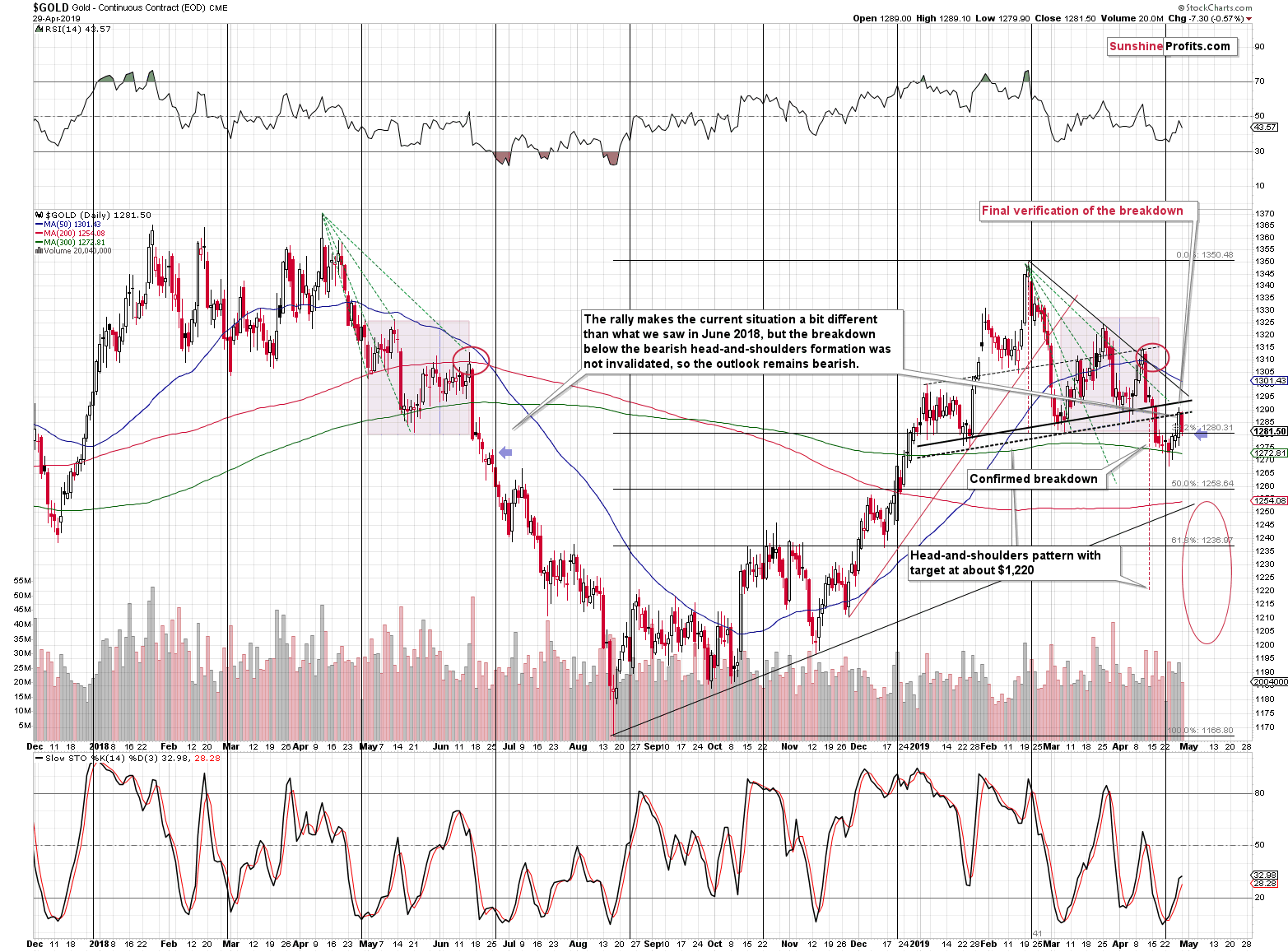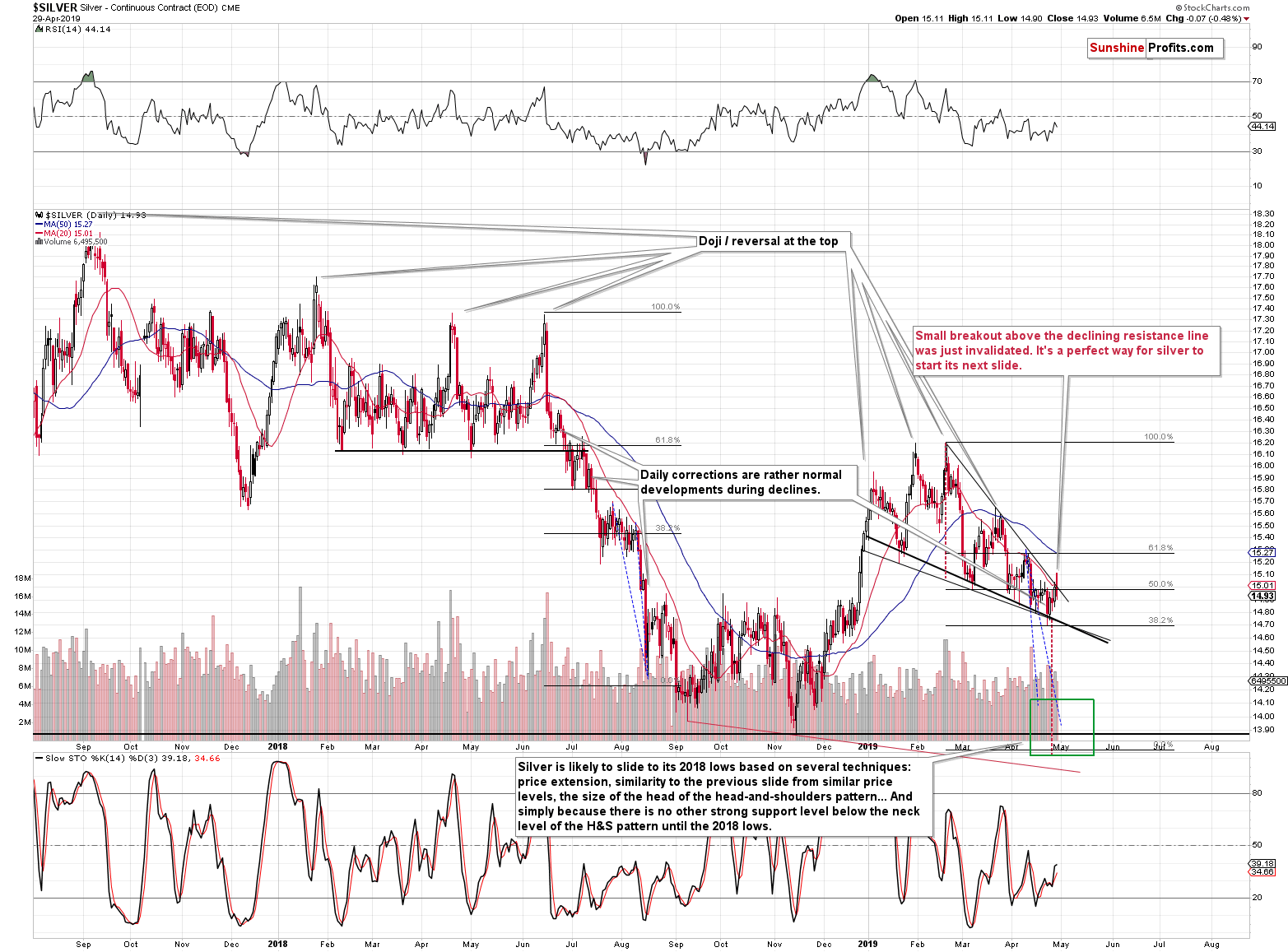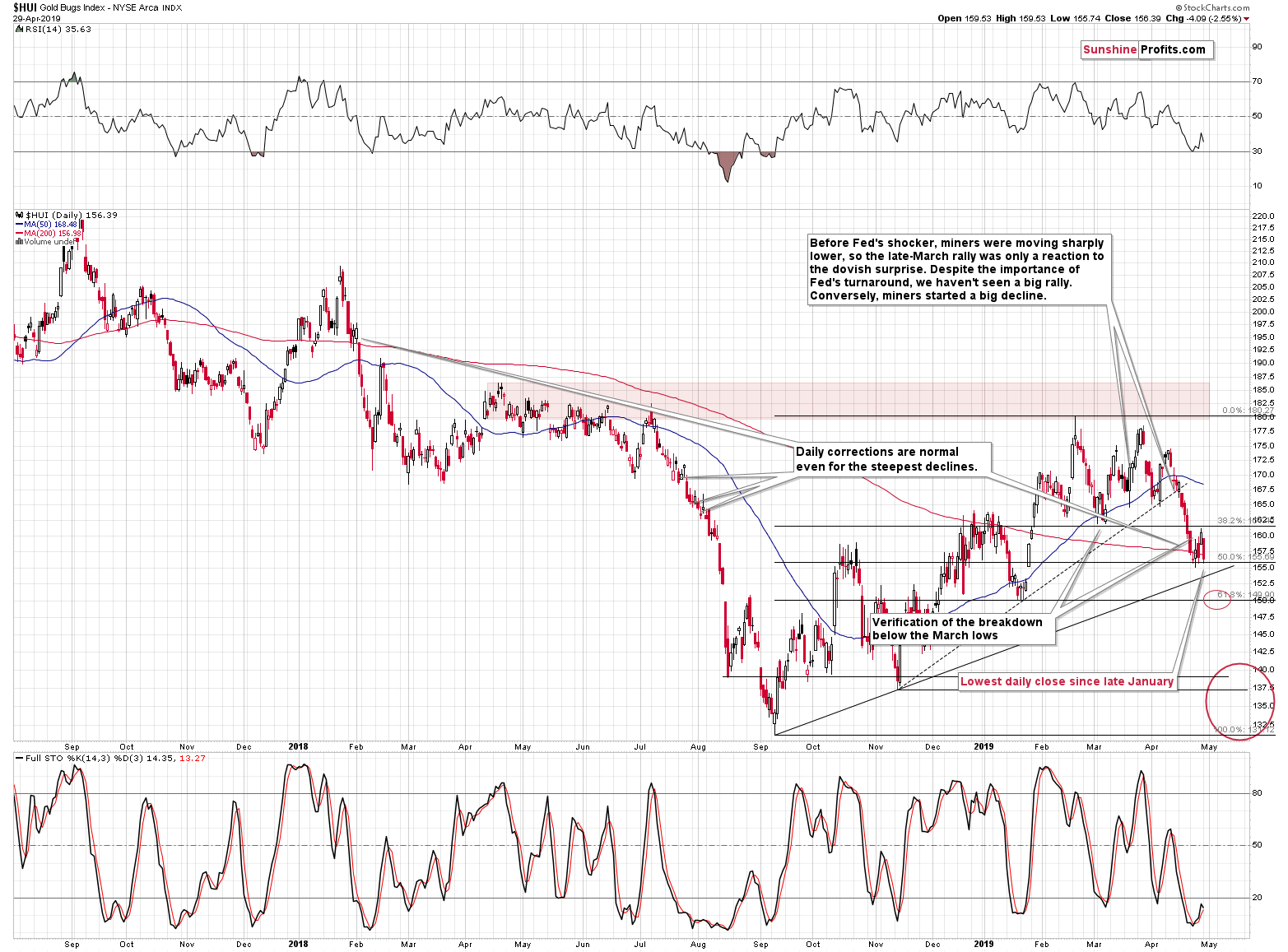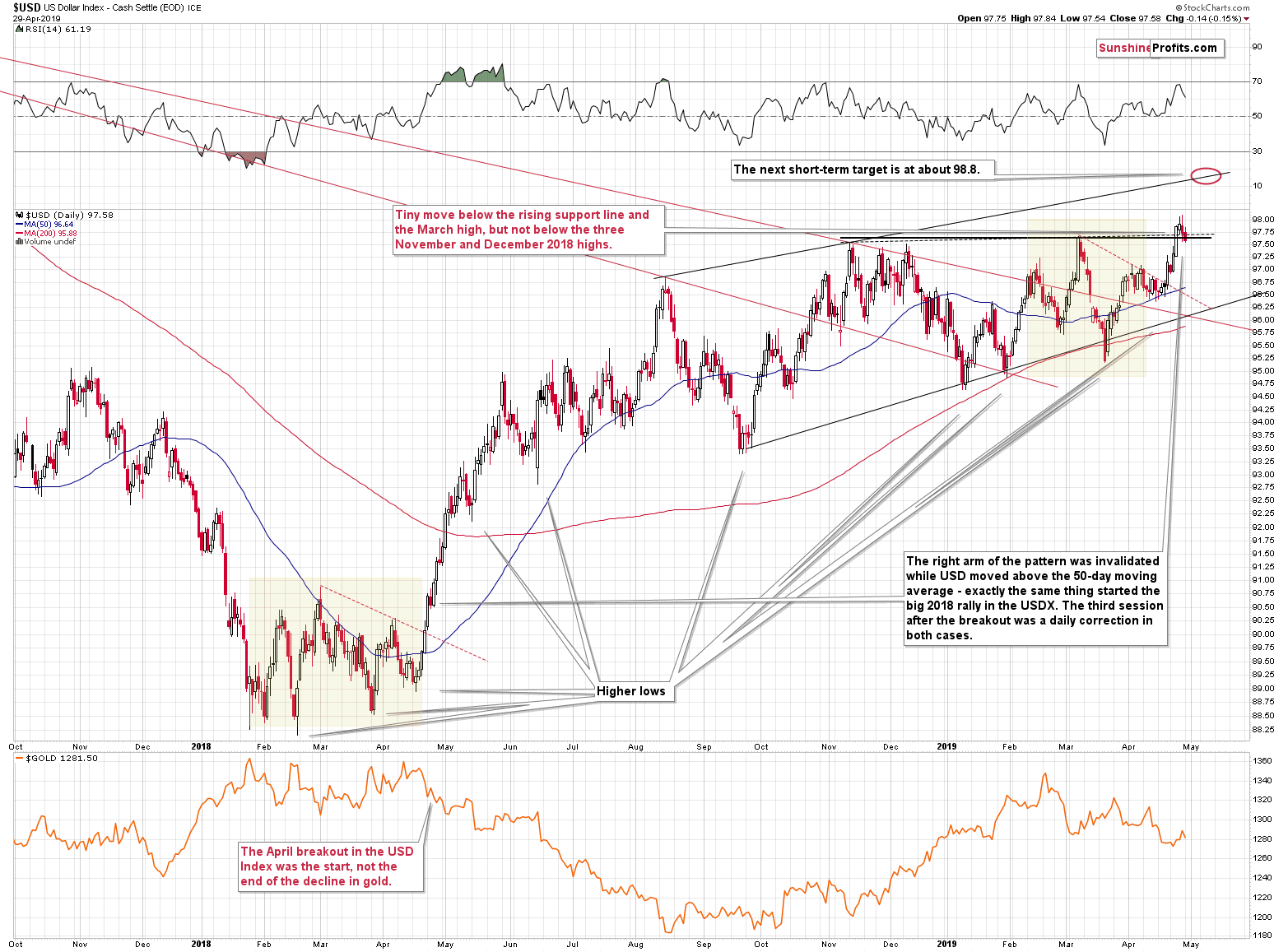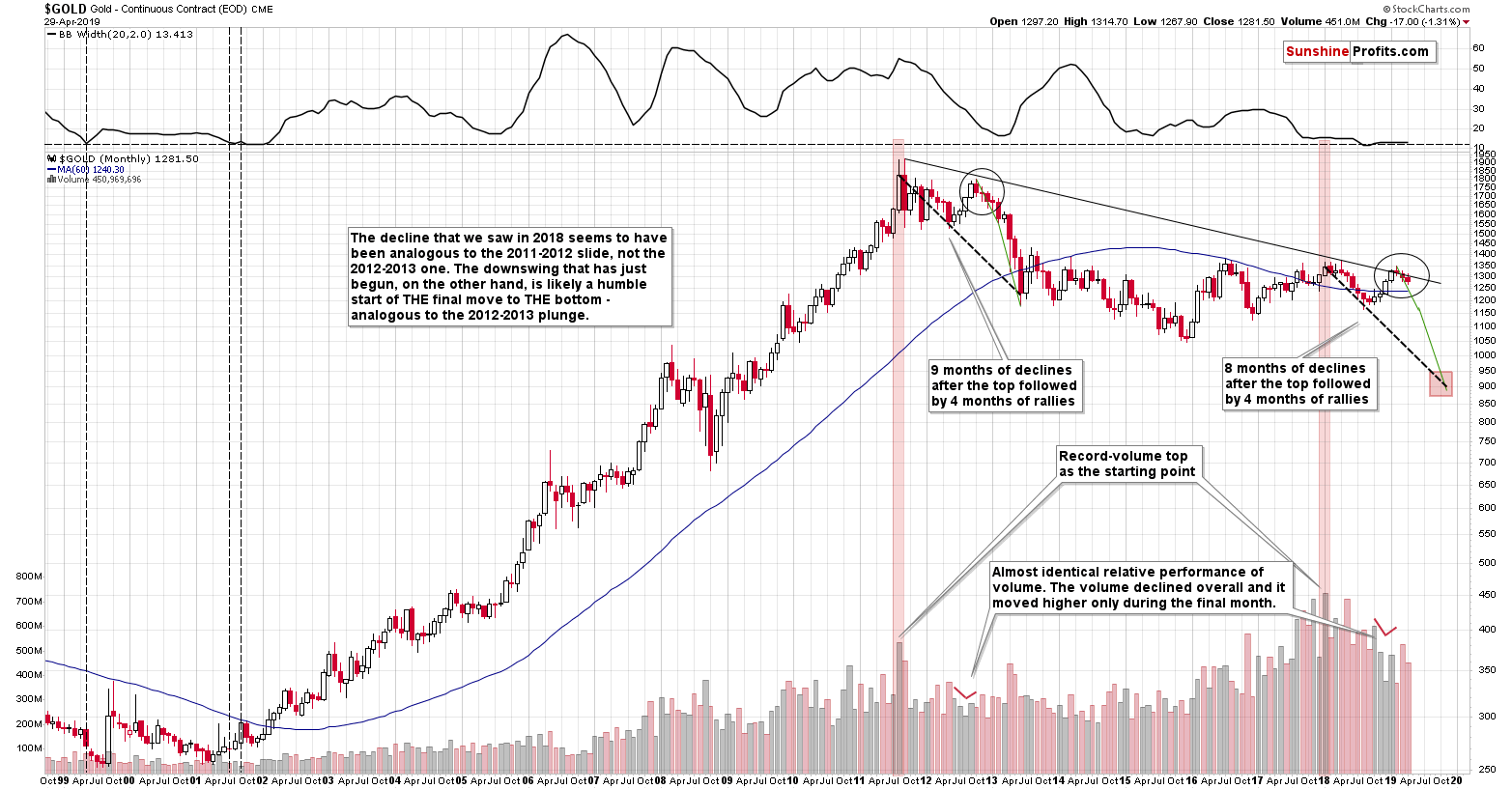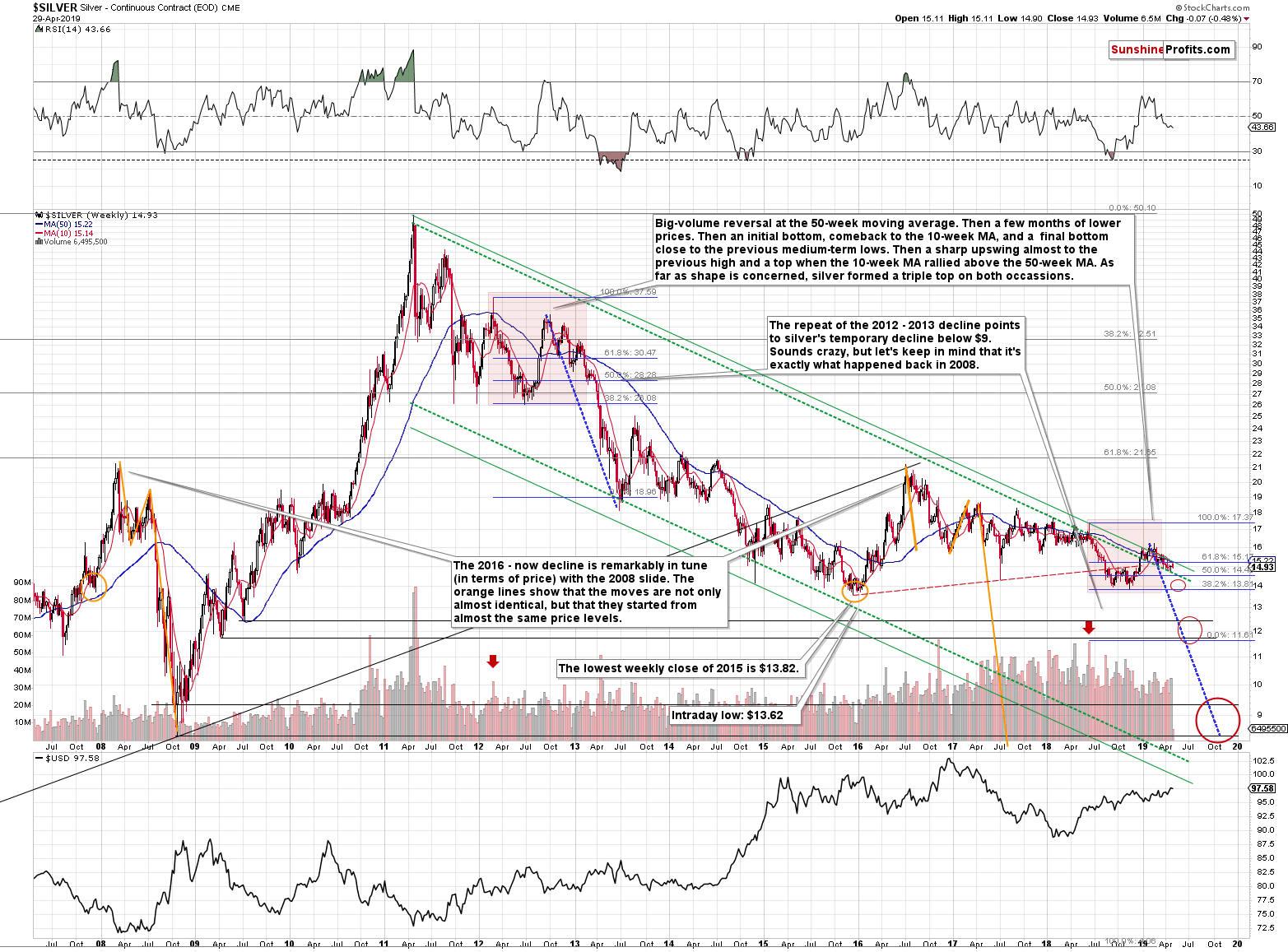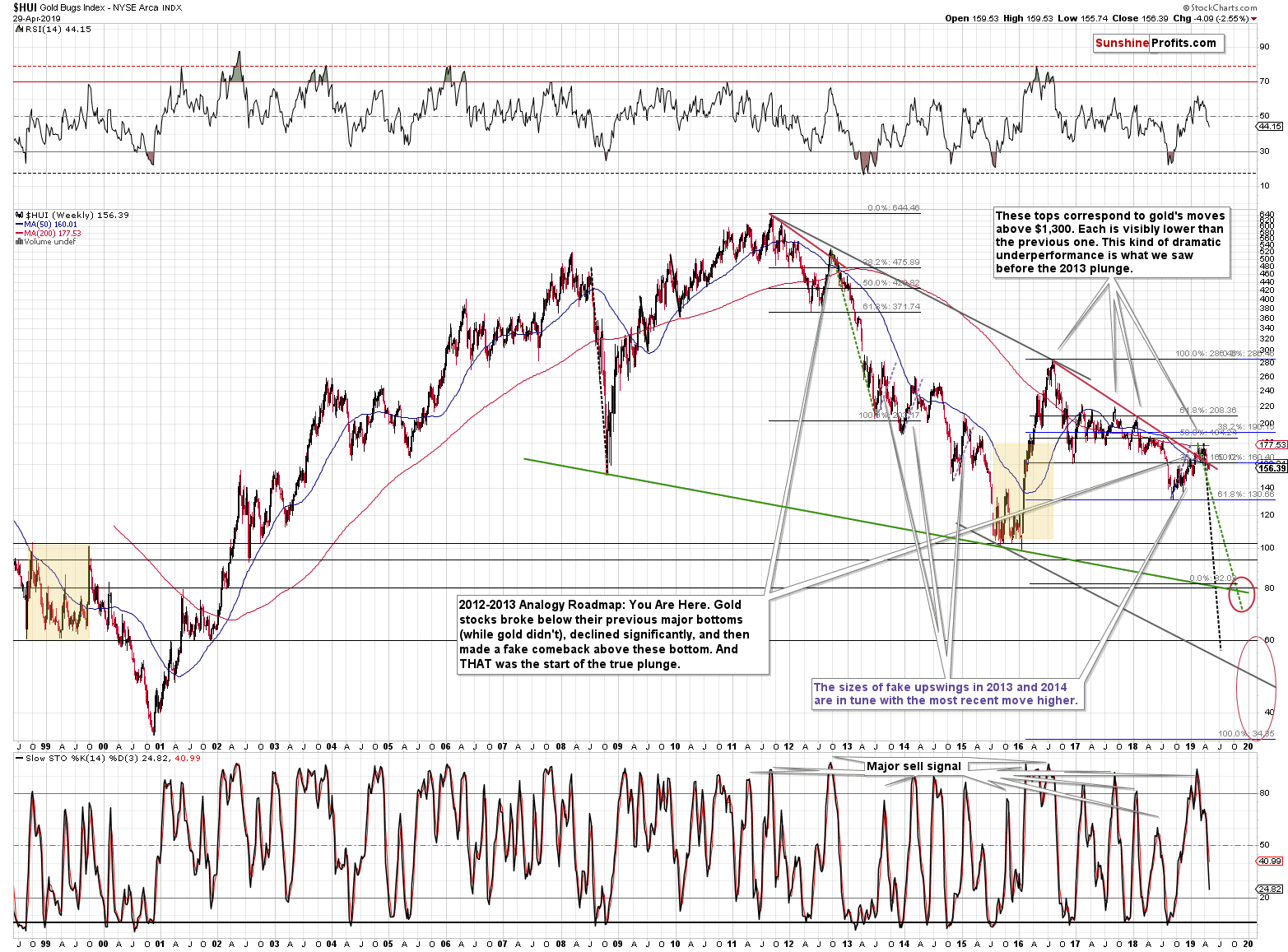Briefly: in our opinion, full (250% of the regular size of the position) speculative short position in gold, silver, and mining stocks is justified from the risk/reward perspective at the moment of publishing this Alert.
Gold miners' small rally is over. The HUI Index just closed (a bit, but still) below its previous April low and all it took was just one session. Gold verified its breakdown below the head-and-shoulders top by moving temporarily back to the neck level and then declining once again. And silver? Silver provided the most classic bearish sign of them all. It broke above its resistance line only to invalidate it shortly thereafter. That's exactly how silver slides start. Let's buckle up and enjoy the ride lower. And in the meantime, we'll examine the long-term charts, outlook and milestones - after all, what good is an analysis of each tree, if one misses the forest?
Before proceeding to the big picture, let's take a quick glance at what changed on the short-term charts. "Quick", because practically everything that we wrote yesterday, remains up-to-date as metals and miners moved as we had expected.
Short-term Details
Quoting our yesterday's analysis:
The yellow metal moved higher, but it only reached the neck level of the previously broken head-and-shoulders pattern. It didn't break above it. And that's the neck level that we get by connecting the previous intraday lows, not the - more meaningful - ones based on the closing prices. Consequently, nothing really changed, and gold is still likely to slide shortly. Let's keep in mind that the target based on the H&S pattern is at about $1,220, so our $1,240 target is actually relatively conservative.
The breakout is confirmed and verified. Consequently, gold is very likely to slide shortly.
Once again, we will start with a quote from yesterday's Alert:
As far as silver is concerned, we haven't seen anything new from the technical point of view. Silver remains in a rather steep downtrend and it simply once again moved to the declining resistance line. This means that it's just as likely to decline as it was likely to before Friday's upswing. In fact, silver is now even more likely to decline, precisely because of the resistance that has been reached. The latter limits how far silver could move up before declining once again. This is not a sure bet, though. Silver sometimes fakes out instead of breaking out just to fool inexperienced precious metals traders. Consequently, even if silver moved higher today or tomorrow, and gold didn't invalidate the head-and-shoulders pattern, the silver outlook would still remain bearish.
That's exactly what happened. Silver moved higher, broke above the declining resistance line and then quickly invalidated this move by declining. We saw a silver fakeout, which makes it even more likely that we'll see another powerful slide shortly - likely this week.
Yesterday's move lower in gold stocks was big enough to erase all the recent upswings in one go. Did gold manage to do the same thing? No, not even close. This means that miners' extreme underperformance continues, and the implications are very bearish. It's very bearish not only on its own, but also because that's exactly what was taking place during the 2012-2013 slide. The extremely bearish link to it is therefore confirmed.
We didn't see a close at new April lows in case of the XAU index and the GDX ETF, but they were both very close to their previous April lows, so overall, they don't invalidate the points made but, but rather confirm it.
One might think that gold or mining stocks need a trigger in the form of a daily rally in the USDX in order to decline, but this is not really the case.
USD Index Trigger: Not Necessarily Needed
The precious metals sector has some catching up to do, so eventually it's likely to move lower regardless of what the USD Index does on a short-term basis. Yesterday is a good example. The HUI Index just moved significantly lower even though the USD moved lower as well.
Speaking of the USD Index's move lower, it invalidated the breakout above the March high and the rising resistance line, but it confirmed the breakout above the three 2018 highs. The implications are rather mixed at first sight, but looking a bit closer provides us with a bullish sign. Namely, after all previous - unsuccessful - attempts to break above 97.50, the US dollar quickly moved back below 97. This time we're seeing nothing like that. This time truly is different, and yesterday's reaction in the PMs suggests that the PM investors are starting to realize it. As it becomes increasingly clearer, metals' and miners' decline is likely to accelerate.
Having said the above, let's take a look at the long-term charts.
Gold's monthly chart shows that the decline is progressing as expected. This is the third month of the medium-term slide, so it's no wonder that gold doesn't decline faster. If you take a closer look at the third month of the previous decline (December 2012), you'll see that it was when gold declined on a temporary basis only to move back up before the month was over. This move lower is what we might see this week. Unless it happens today, it will already be a part of May, but it doesn't change much. With long-term analogies, a weekly or bi-weekly deviation from the otherwise near-perfect link is nothing to worry about. After all, the history is not likely to completely repeat itself, but rather to rhyme.
One more thing that we would like to add here is a note on the volume levels. In relative terms, they continue to be remarkably similar to what we saw in 2012. We discussed it a few months ago, but the similarity continued thereafter. The red "inverse checkmarks" that we drew on the lower part of the above chart illustrate what we already covered. What followed was a monthly decline on relatively low volume, then a decline on relatively high volume and then once again a decline on relatively low volume. Of course, April is not yet over, and one session's volume will need to be added, but it's not likely to change much. Unless we see something really profound today, April's volume will not exceed the March volume. Consequently, the link between now and the 2012-2013 decline continues to be confirmed in the increasing number of factors.
The Long-term Outlook
As far as silver's long-term chart is concerned, we would like to say two things:
- Our previous comments on it remain up-to-date
- We added the blue Fibonacci retracement tool as a way to create Fibonacci price extensions.
As far as the first point is concerned, if you're new to our service, and you haven't seen the above chart previously, we encourage you to dedicate some time to it. The most interesting - and useful - part thereof is the surprising analogy between 2016 - now and 2008. We marked the starting point of the analogy with an orange ellipse, and the sizes of the moves with orange lines. While the shape of the moves is different and the analogy is not present in terms of time, there is a clear and quite precise link in terms of prices. The implication is that silver is likely to slide below $10, perhaps below $9, before the decline is over. Yes, that's "unreasonable expectation", but hey - silver already did that 11 years ago, starting the decline from even higher levels than the current ones.
Another thing is that the red rectangles show the link between 2012 and 2018. In particular, the big-volume weekly reversal at the 10-week moving average is an analogous starting point for the price moves. The blue dashed line shows the where silver is likely heading if the 2012-2013 - now link continues. Based on this technique, silver is also likely to slide below $9.
Moving to the second point, we just realized that since the price moves are very similar between now and in case of the 2012-2013 decline, we might be able to apply a relativity-based technique to determine one of the downside target prices for silver. In 2013, the most volatile part of the decline ended very close to the 1.618 price extension of the initial decline. The blue Fibonacci retracement (used as a price extension tool) shows exactly that. We already saw the initial decline in silver, so we can apply the same technique to determine the next big target. It's about $11.60, which is very close to the April 2009 bottom of $11.72. The latter was one of our target prices for silver's slide even before applying the above technique, but using it makes it much more reliable. This means that while silver might reverse close to the July 2009 bottom of about $12.44, it's more likely to then quickly slide lower and start a more meaningful corrective upswing from below $12 - likely from about $11.70.
Finally, let's turn to the gold miners' long-term chart.
We have nothing new to tell you about it, except that the price is declining in tune with the analogy to the 2012-2013 slide. The key sign that we just saw is the invalidation of the previous breakout above the declining red resistance line and both: 50-week, and 200-week moving averages. It was exactly this sign that started the biggest part of the 2012-2013 slide. The top in the mining stocks (and the rest of the precious metals sector) appears to be in and much lower values appear to be just around the corner.
Summary
Summing up, there are multiple short-term and medium-term signs pointing to a powerful slide in the precious metals market in the following months, weeks, and - quite likely - days. There will likely come a time later this year when we will get in the back-up-the-truck territory with regard to precious metals, but we are not even close to these discounted price levels. However, it looks like the final slide towards them has already started. Based on the likelihood of seeing a temporary turnaround this week, we might have a good chance of exiting the current short position or even switching to a long one at that time.
As always, we'll keep you - our subscribers - informed.
To summarize:
Trading capital (supplementary part of the portfolio; our opinion): Full short position (250% of the full position) in gold, silver, and mining stocks is justified from the risk/reward perspective with the following stop-loss orders and exit profit-take price levels:
- Gold: profit-take exit price: $1,241; stop-loss: $1,357; initial target price for the DGLD ETN: $51.87; stop-loss for the DGLD ETN $39.87
- Silver: profit-take exit price: $14.03; stop-loss: $15.72; initial target price for the DSLV ETN: $37.47; stop-loss for the DSLV ETN $26.97
- Mining stocks (price levels for the GDX ETF): profit-take exit price: $18.41; stop-loss: $24.17; initial target price for the DUST ETF: $34.28; stop-loss for the DUST ETF $15.47
In case one wants to bet on junior mining stocks' prices (we do not suggest doing so - we think senior mining stocks are more predictable in the case of short-term trades - if one wants to do it anyway, we provide the details), here are the stop-loss details and target prices:
- GDXJ ETF: profit-take exit price: $26.42; stop-loss: $35.67
- JDST ETF: profit-take exit price: $78.21 stop-loss: $30.97
Long-term capital (core part of the portfolio; our opinion): No positions (in other words: cash)
Insurance capital (core part of the portfolio; our opinion): Full position
Whether you already subscribed or not, we encourage you to find out how to make the most of our alerts and read our replies to the most common alert-and-gold-trading-related-questions.
Please note that the in the trading section we describe the situation for the day that the alert is posted. In other words, it we are writing about a speculative position, it means that it is up-to-date on the day it was posted. We are also featuring the initial target prices, so that you can decide whether keeping a position on a given day is something that is in tune with your approach (some moves are too small for medium-term traders and some might appear too big for day-traders).
Plus, you might want to read why our stop-loss orders are usually relatively far from the current price.
Please note that a full position doesn't mean using all of the capital for a given trade. You will find details on our thoughts on gold portfolio structuring in the Key Insights section on our website.
As a reminder - "initial target price" means exactly that - an "initial" one, it's not a price level at which we suggest closing positions. If this becomes the case (like it did in the previous trade) we will refer to these levels as levels of exit orders (exactly as we've done previously). Stop-loss levels, however, are naturally not "initial", but something that, in our opinion, might be entered as an order.
Since it is impossible to synchronize target prices and stop-loss levels for all the ETFs and ETNs with the main markets that we provide these levels for (gold, silver and mining stocks - the GDX ETF), the stop-loss levels and target prices for other ETNs and ETF (among other: UGLD, DGLD, USLV, DSLV, NUGT, DUST, JNUG, JDST) are provided as supplementary, and not as "final". This means that if a stop-loss or a target level is reached for any of the "additional instruments" (DGLD for instance), but not for the "main instrument" (gold in this case), we will view positions in both gold and DGLD as still open and the stop-loss for DGLD would have to be moved lower. On the other hand, if gold moves to a stop-loss level but DGLD doesn't, then we will view both positions (in gold and DGLD) as closed. In other words, since it's not possible to be 100% certain that each related instrument moves to a given level when the underlying instrument does, we can't provide levels that would be binding. The levels that we do provide are our best estimate of the levels that will correspond to the levels in the underlying assets, but it will be the underlying assets that one will need to focus on regarding the signs pointing to closing a given position or keeping it open. We might adjust the levels in the "additional instruments" without adjusting the levels in the "main instruments", which will simply mean that we have improved our estimation of these levels, not that we changed our outlook on the markets. We are already working on a tool that would update these levels on a daily basis for the most popular ETFs, ETNs and individual mining stocks.
Our preferred ways to invest in and to trade gold along with the reasoning can be found in the how to buy gold section. Additionally, our preferred ETFs and ETNs can be found in our Gold & Silver ETF Ranking.
As a reminder, Gold & Silver Trading Alerts are posted before or on each trading day (we usually post them before the opening bell, but we don't promise doing that each day). If there's anything urgent, we will send you an additional small alert before posting the main one.
=====
Latest Free Trading Alerts:
The US economic growth in the Q1 2019 positively surprised. Indeed, on the upside. The doubting Thomasses were proven wrong. And The Socialist Party just won the snap elections in Spain. Is the left back in vogue in the Eurozone? But what does it all mean for the gold market?
U.S. GDP Accelerates, while Socialists Triumph in Spain. Will Gold also Win?
=====
Thank you.
Sincerely,
Przemyslaw Radomski, CFA
Editor-in-chief, Gold & Silver Fund Manager


